CBH290: Immunity, Immunization, and Antibiotic Resistance Analysis
VerifiedAdded on 2022/12/26
|9
|1974
|3
Homework Assignment
AI Summary
This assignment delves into the concepts of immunity, immunization, and antibiotic resistance, covering key definitions and processes. It explains different types of immunity, including natural active, natural passive, artificial active, and artificial passive immunity, with detailed explanations of antibody formation. The assignment analyzes the impact of the measles/MMR mass immunization program in the UK, examining vaccination rates and the rise and fall of measles cases. Furthermore, it investigates the long-term effects of antibiotics on pathogen resistance, exploring how bacteria develop resistance mechanisms and the implications of antibiotic overuse. The document also touches upon detection and prevention strategies for antibiotic-resistant infections, emphasizing the importance of hygiene, nutrition, and appropriate antibiotic use. The content is based on the assignment brief for the Diploma Access to H.E. Health Professions, covering infectious diseases and related topics.
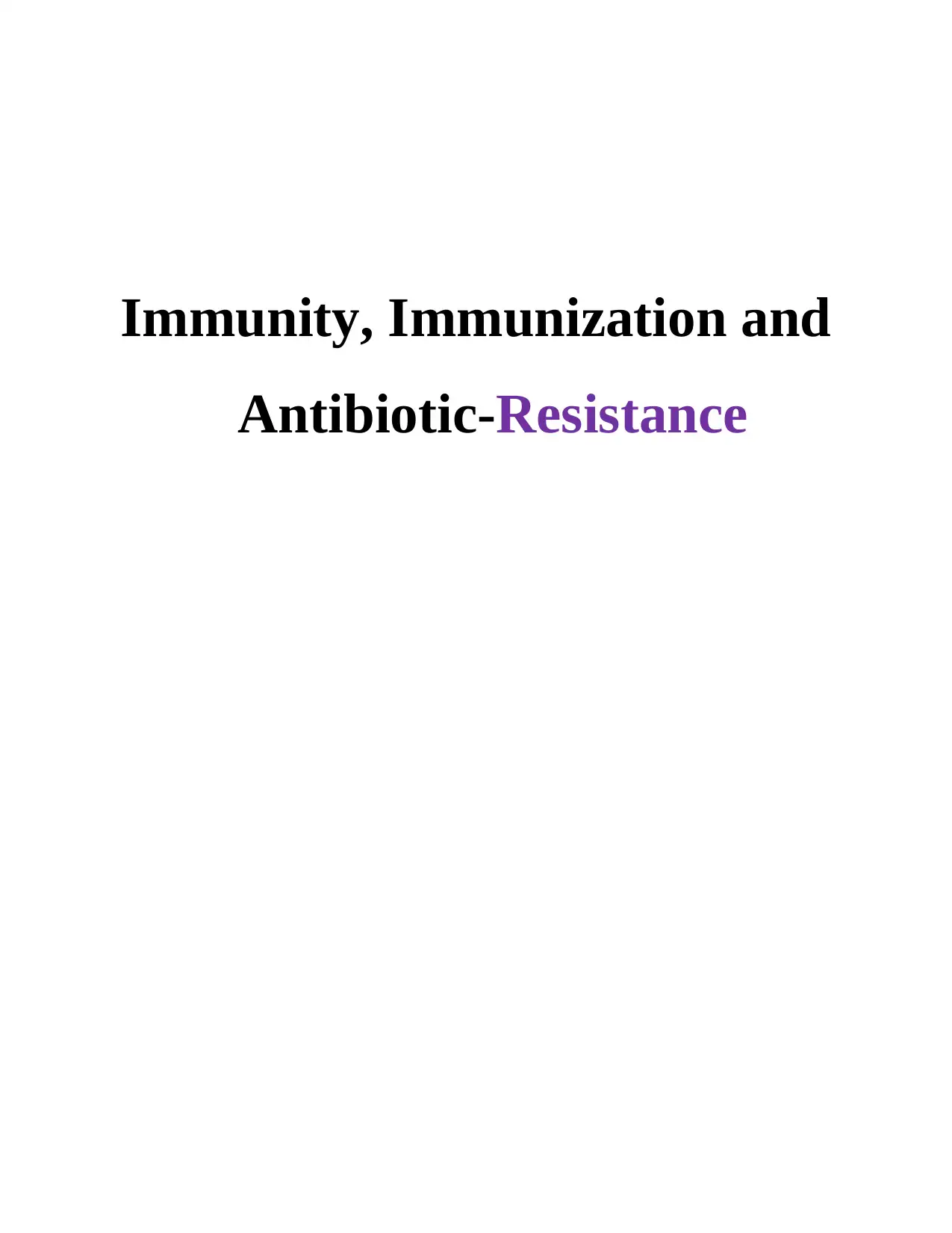
Immunity, Immunization and
Antibiotic-Resistance
Antibiotic-Resistance
Paraphrase This Document
Need a fresh take? Get an instant paraphrase of this document with our AI Paraphraser
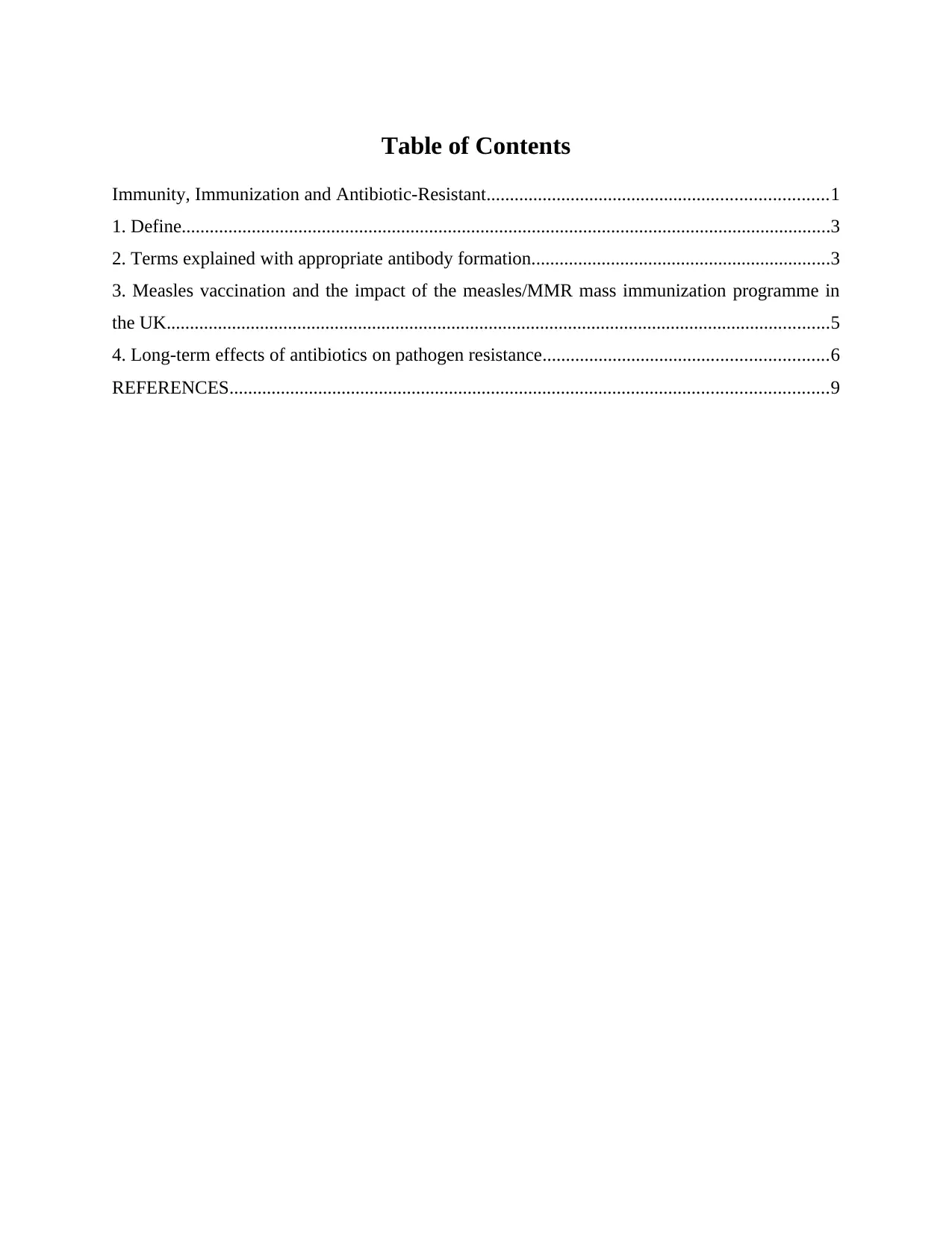
Table of Contents
Immunity, Immunization and Antibiotic-Resistant.........................................................................1
1. Define...........................................................................................................................................3
2. Terms explained with appropriate antibody formation................................................................3
3. Measles vaccination and the impact of the measles/MMR mass immunization programme in
the UK..............................................................................................................................................5
4. Long-term effects of antibiotics on pathogen resistance.............................................................6
REFERENCES................................................................................................................................9
Immunity, Immunization and Antibiotic-Resistant.........................................................................1
1. Define...........................................................................................................................................3
2. Terms explained with appropriate antibody formation................................................................3
3. Measles vaccination and the impact of the measles/MMR mass immunization programme in
the UK..............................................................................................................................................5
4. Long-term effects of antibiotics on pathogen resistance.............................................................6
REFERENCES................................................................................................................................9
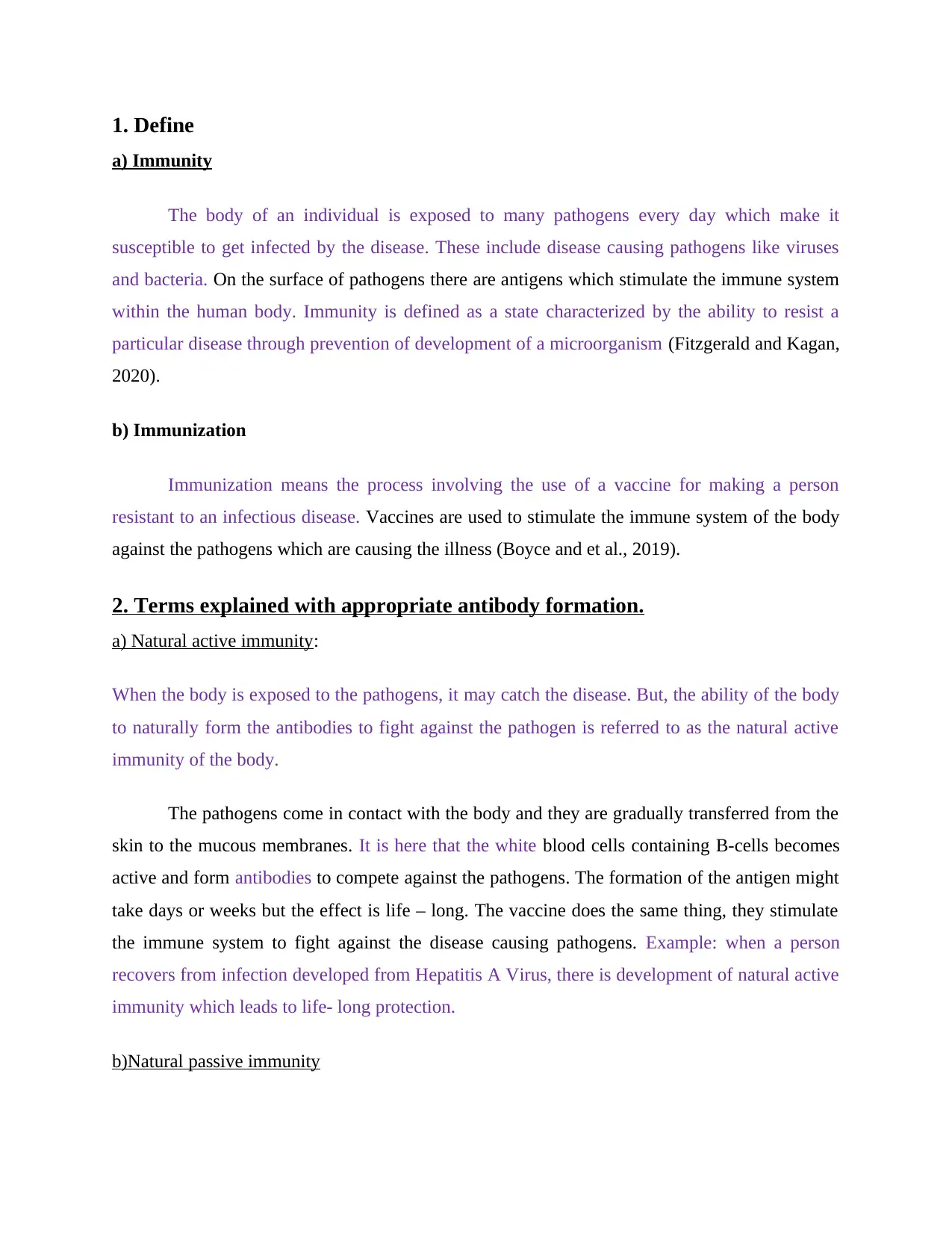
1. Define
a) Immunity
The body of an individual is exposed to many pathogens every day which make it
susceptible to get infected by the disease. These include disease causing pathogens like viruses
and bacteria. On the surface of pathogens there are antigens which stimulate the immune system
within the human body. Immunity is defined as a state characterized by the ability to resist a
particular disease through prevention of development of a microorganism (Fitzgerald and Kagan,
2020).
b) Immunization
Immunization means the process involving the use of a vaccine for making a person
resistant to an infectious disease. Vaccines are used to stimulate the immune system of the body
against the pathogens which are causing the illness (Boyce and et al., 2019).
2. Terms explained with appropriate antibody formation.
a) Natural active immunity:
When the body is exposed to the pathogens, it may catch the disease. But, the ability of the body
to naturally form the antibodies to fight against the pathogen is referred to as the natural active
immunity of the body.
The pathogens come in contact with the body and they are gradually transferred from the
skin to the mucous membranes. It is here that the white blood cells containing B-cells becomes
active and form antibodies to compete against the pathogens. The formation of the antigen might
take days or weeks but the effect is life – long. The vaccine does the same thing, they stimulate
the immune system to fight against the disease causing pathogens. Example: when a person
recovers from infection developed from Hepatitis A Virus, there is development of natural active
immunity which leads to life- long protection.
b)Natural passive immunity
a) Immunity
The body of an individual is exposed to many pathogens every day which make it
susceptible to get infected by the disease. These include disease causing pathogens like viruses
and bacteria. On the surface of pathogens there are antigens which stimulate the immune system
within the human body. Immunity is defined as a state characterized by the ability to resist a
particular disease through prevention of development of a microorganism (Fitzgerald and Kagan,
2020).
b) Immunization
Immunization means the process involving the use of a vaccine for making a person
resistant to an infectious disease. Vaccines are used to stimulate the immune system of the body
against the pathogens which are causing the illness (Boyce and et al., 2019).
2. Terms explained with appropriate antibody formation.
a) Natural active immunity:
When the body is exposed to the pathogens, it may catch the disease. But, the ability of the body
to naturally form the antibodies to fight against the pathogen is referred to as the natural active
immunity of the body.
The pathogens come in contact with the body and they are gradually transferred from the
skin to the mucous membranes. It is here that the white blood cells containing B-cells becomes
active and form antibodies to compete against the pathogens. The formation of the antigen might
take days or weeks but the effect is life – long. The vaccine does the same thing, they stimulate
the immune system to fight against the disease causing pathogens. Example: when a person
recovers from infection developed from Hepatitis A Virus, there is development of natural active
immunity which leads to life- long protection.
b)Natural passive immunity
⊘ This is a preview!⊘
Do you want full access?
Subscribe today to unlock all pages.

Trusted by 1+ million students worldwide
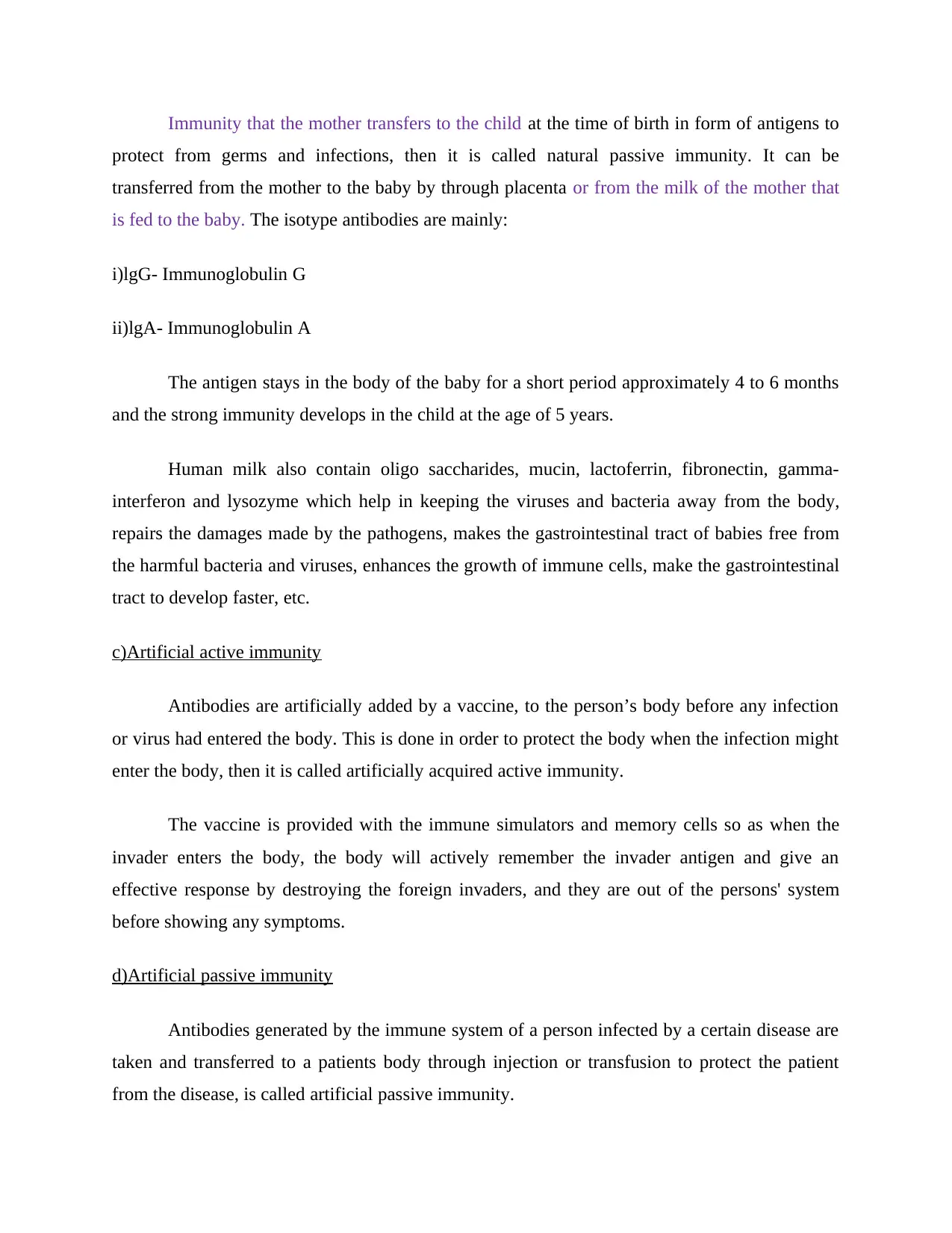
Immunity that the mother transfers to the child at the time of birth in form of antigens to
protect from germs and infections, then it is called natural passive immunity. It can be
transferred from the mother to the baby by through placenta or from the milk of the mother that
is fed to the baby. The isotype antibodies are mainly:
i)lgG- Immunoglobulin G
ii)lgA- Immunoglobulin A
The antigen stays in the body of the baby for a short period approximately 4 to 6 months
and the strong immunity develops in the child at the age of 5 years.
Human milk also contain oligo saccharides, mucin, lactoferrin, fibronectin, gamma-
interferon and lysozyme which help in keeping the viruses and bacteria away from the body,
repairs the damages made by the pathogens, makes the gastrointestinal tract of babies free from
the harmful bacteria and viruses, enhances the growth of immune cells, make the gastrointestinal
tract to develop faster, etc.
c)Artificial active immunity
Antibodies are artificially added by a vaccine, to the person’s body before any infection
or virus had entered the body. This is done in order to protect the body when the infection might
enter the body, then it is called artificially acquired active immunity.
The vaccine is provided with the immune simulators and memory cells so as when the
invader enters the body, the body will actively remember the invader antigen and give an
effective response by destroying the foreign invaders, and they are out of the persons' system
before showing any symptoms.
d)Artificial passive immunity
Antibodies generated by the immune system of a person infected by a certain disease are
taken and transferred to a patients body through injection or transfusion to protect the patient
from the disease, is called artificial passive immunity.
protect from germs and infections, then it is called natural passive immunity. It can be
transferred from the mother to the baby by through placenta or from the milk of the mother that
is fed to the baby. The isotype antibodies are mainly:
i)lgG- Immunoglobulin G
ii)lgA- Immunoglobulin A
The antigen stays in the body of the baby for a short period approximately 4 to 6 months
and the strong immunity develops in the child at the age of 5 years.
Human milk also contain oligo saccharides, mucin, lactoferrin, fibronectin, gamma-
interferon and lysozyme which help in keeping the viruses and bacteria away from the body,
repairs the damages made by the pathogens, makes the gastrointestinal tract of babies free from
the harmful bacteria and viruses, enhances the growth of immune cells, make the gastrointestinal
tract to develop faster, etc.
c)Artificial active immunity
Antibodies are artificially added by a vaccine, to the person’s body before any infection
or virus had entered the body. This is done in order to protect the body when the infection might
enter the body, then it is called artificially acquired active immunity.
The vaccine is provided with the immune simulators and memory cells so as when the
invader enters the body, the body will actively remember the invader antigen and give an
effective response by destroying the foreign invaders, and they are out of the persons' system
before showing any symptoms.
d)Artificial passive immunity
Antibodies generated by the immune system of a person infected by a certain disease are
taken and transferred to a patients body through injection or transfusion to protect the patient
from the disease, is called artificial passive immunity.
Paraphrase This Document
Need a fresh take? Get an instant paraphrase of this document with our AI Paraphraser
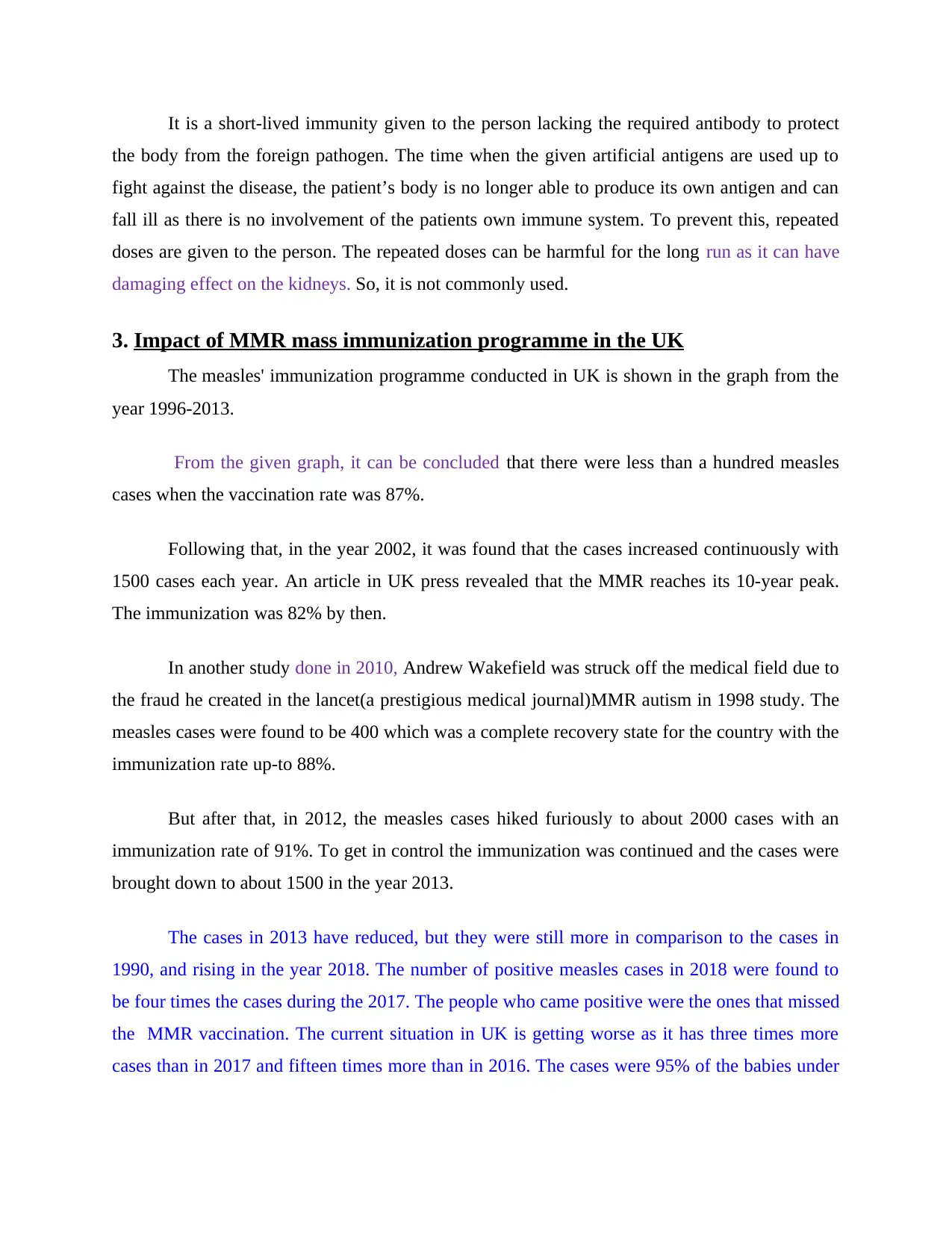
It is a short-lived immunity given to the person lacking the required antibody to protect
the body from the foreign pathogen. The time when the given artificial antigens are used up to
fight against the disease, the patient’s body is no longer able to produce its own antigen and can
fall ill as there is no involvement of the patients own immune system. To prevent this, repeated
doses are given to the person. The repeated doses can be harmful for the long run as it can have
damaging effect on the kidneys. So, it is not commonly used.
3. Impact of MMR mass immunization programme in the UK
The measles' immunization programme conducted in UK is shown in the graph from the
year 1996-2013.
From the given graph, it can be concluded that there were less than a hundred measles
cases when the vaccination rate was 87%.
Following that, in the year 2002, it was found that the cases increased continuously with
1500 cases each year. An article in UK press revealed that the MMR reaches its 10-year peak.
The immunization was 82% by then.
In another study done in 2010, Andrew Wakefield was struck off the medical field due to
the fraud he created in the lancet(a prestigious medical journal)MMR autism in 1998 study. The
measles cases were found to be 400 which was a complete recovery state for the country with the
immunization rate up-to 88%.
But after that, in 2012, the measles cases hiked furiously to about 2000 cases with an
immunization rate of 91%. To get in control the immunization was continued and the cases were
brought down to about 1500 in the year 2013.
The cases in 2013 have reduced, but they were still more in comparison to the cases in
1990, and rising in the year 2018. The number of positive measles cases in 2018 were found to
be four times the cases during the 2017. The people who came positive were the ones that missed
the MMR vaccination. The current situation in UK is getting worse as it has three times more
cases than in 2017 and fifteen times more than in 2016. The cases were 95% of the babies under
the body from the foreign pathogen. The time when the given artificial antigens are used up to
fight against the disease, the patient’s body is no longer able to produce its own antigen and can
fall ill as there is no involvement of the patients own immune system. To prevent this, repeated
doses are given to the person. The repeated doses can be harmful for the long run as it can have
damaging effect on the kidneys. So, it is not commonly used.
3. Impact of MMR mass immunization programme in the UK
The measles' immunization programme conducted in UK is shown in the graph from the
year 1996-2013.
From the given graph, it can be concluded that there were less than a hundred measles
cases when the vaccination rate was 87%.
Following that, in the year 2002, it was found that the cases increased continuously with
1500 cases each year. An article in UK press revealed that the MMR reaches its 10-year peak.
The immunization was 82% by then.
In another study done in 2010, Andrew Wakefield was struck off the medical field due to
the fraud he created in the lancet(a prestigious medical journal)MMR autism in 1998 study. The
measles cases were found to be 400 which was a complete recovery state for the country with the
immunization rate up-to 88%.
But after that, in 2012, the measles cases hiked furiously to about 2000 cases with an
immunization rate of 91%. To get in control the immunization was continued and the cases were
brought down to about 1500 in the year 2013.
The cases in 2013 have reduced, but they were still more in comparison to the cases in
1990, and rising in the year 2018. The number of positive measles cases in 2018 were found to
be four times the cases during the 2017. The people who came positive were the ones that missed
the MMR vaccination. The current situation in UK is getting worse as it has three times more
cases than in 2017 and fifteen times more than in 2016. The cases were 95% of the babies under
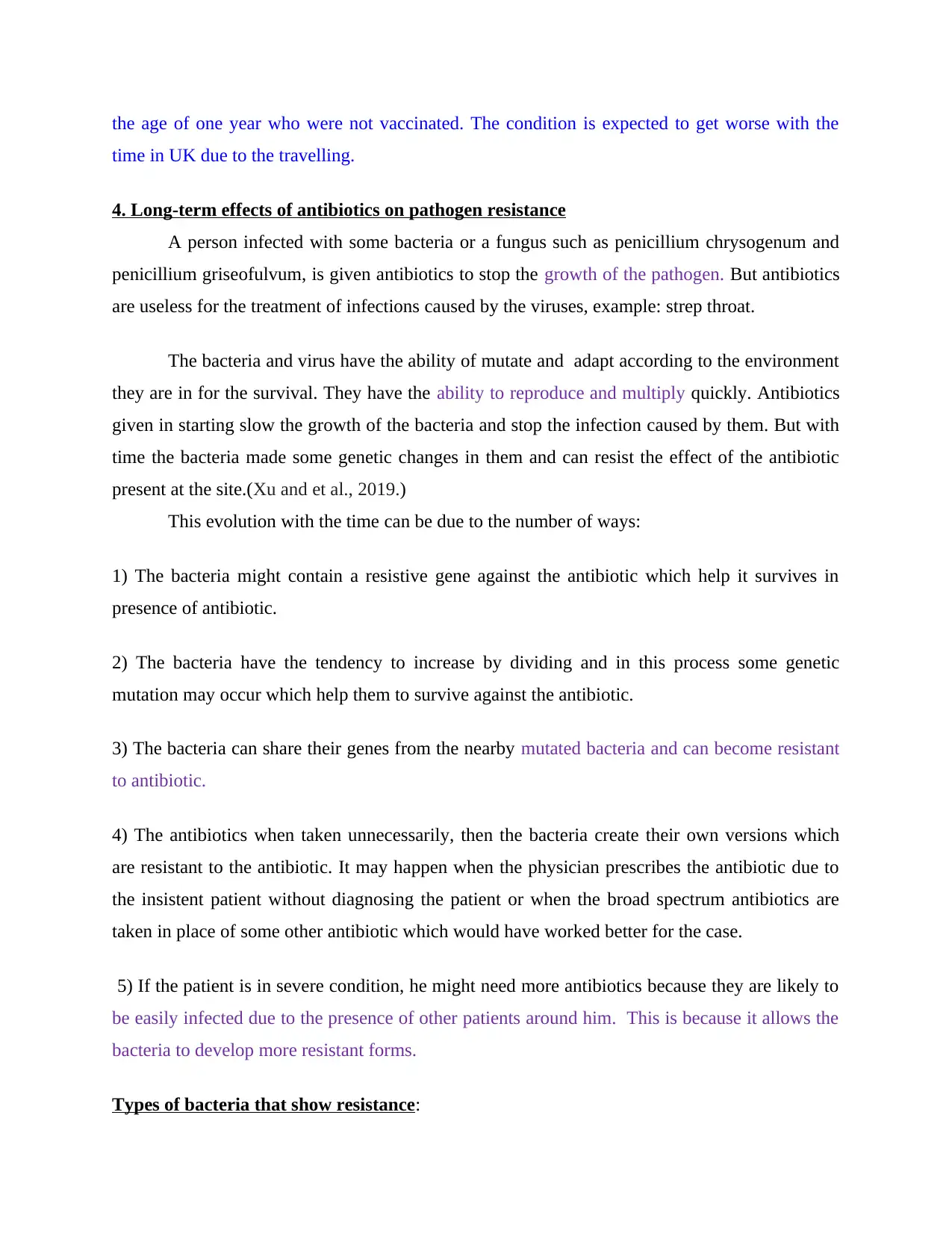
the age of one year who were not vaccinated. The condition is expected to get worse with the
time in UK due to the travelling.
4. Long-term effects of antibiotics on pathogen resistance
A person infected with some bacteria or a fungus such as penicillium chrysogenum and
penicillium griseofulvum, is given antibiotics to stop the growth of the pathogen. But antibiotics
are useless for the treatment of infections caused by the viruses, example: strep throat.
The bacteria and virus have the ability of mutate and adapt according to the environment
they are in for the survival. They have the ability to reproduce and multiply quickly. Antibiotics
given in starting slow the growth of the bacteria and stop the infection caused by them. But with
time the bacteria made some genetic changes in them and can resist the effect of the antibiotic
present at the site.(Xu and et al., 2019.)
This evolution with the time can be due to the number of ways:
1) The bacteria might contain a resistive gene against the antibiotic which help it survives in
presence of antibiotic.
2) The bacteria have the tendency to increase by dividing and in this process some genetic
mutation may occur which help them to survive against the antibiotic.
3) The bacteria can share their genes from the nearby mutated bacteria and can become resistant
to antibiotic.
4) The antibiotics when taken unnecessarily, then the bacteria create their own versions which
are resistant to the antibiotic. It may happen when the physician prescribes the antibiotic due to
the insistent patient without diagnosing the patient or when the broad spectrum antibiotics are
taken in place of some other antibiotic which would have worked better for the case.
5) If the patient is in severe condition, he might need more antibiotics because they are likely to
be easily infected due to the presence of other patients around him. This is because it allows the
bacteria to develop more resistant forms.
Types of bacteria that show resistance:
time in UK due to the travelling.
4. Long-term effects of antibiotics on pathogen resistance
A person infected with some bacteria or a fungus such as penicillium chrysogenum and
penicillium griseofulvum, is given antibiotics to stop the growth of the pathogen. But antibiotics
are useless for the treatment of infections caused by the viruses, example: strep throat.
The bacteria and virus have the ability of mutate and adapt according to the environment
they are in for the survival. They have the ability to reproduce and multiply quickly. Antibiotics
given in starting slow the growth of the bacteria and stop the infection caused by them. But with
time the bacteria made some genetic changes in them and can resist the effect of the antibiotic
present at the site.(Xu and et al., 2019.)
This evolution with the time can be due to the number of ways:
1) The bacteria might contain a resistive gene against the antibiotic which help it survives in
presence of antibiotic.
2) The bacteria have the tendency to increase by dividing and in this process some genetic
mutation may occur which help them to survive against the antibiotic.
3) The bacteria can share their genes from the nearby mutated bacteria and can become resistant
to antibiotic.
4) The antibiotics when taken unnecessarily, then the bacteria create their own versions which
are resistant to the antibiotic. It may happen when the physician prescribes the antibiotic due to
the insistent patient without diagnosing the patient or when the broad spectrum antibiotics are
taken in place of some other antibiotic which would have worked better for the case.
5) If the patient is in severe condition, he might need more antibiotics because they are likely to
be easily infected due to the presence of other patients around him. This is because it allows the
bacteria to develop more resistant forms.
Types of bacteria that show resistance:
⊘ This is a preview!⊘
Do you want full access?
Subscribe today to unlock all pages.

Trusted by 1+ million students worldwide
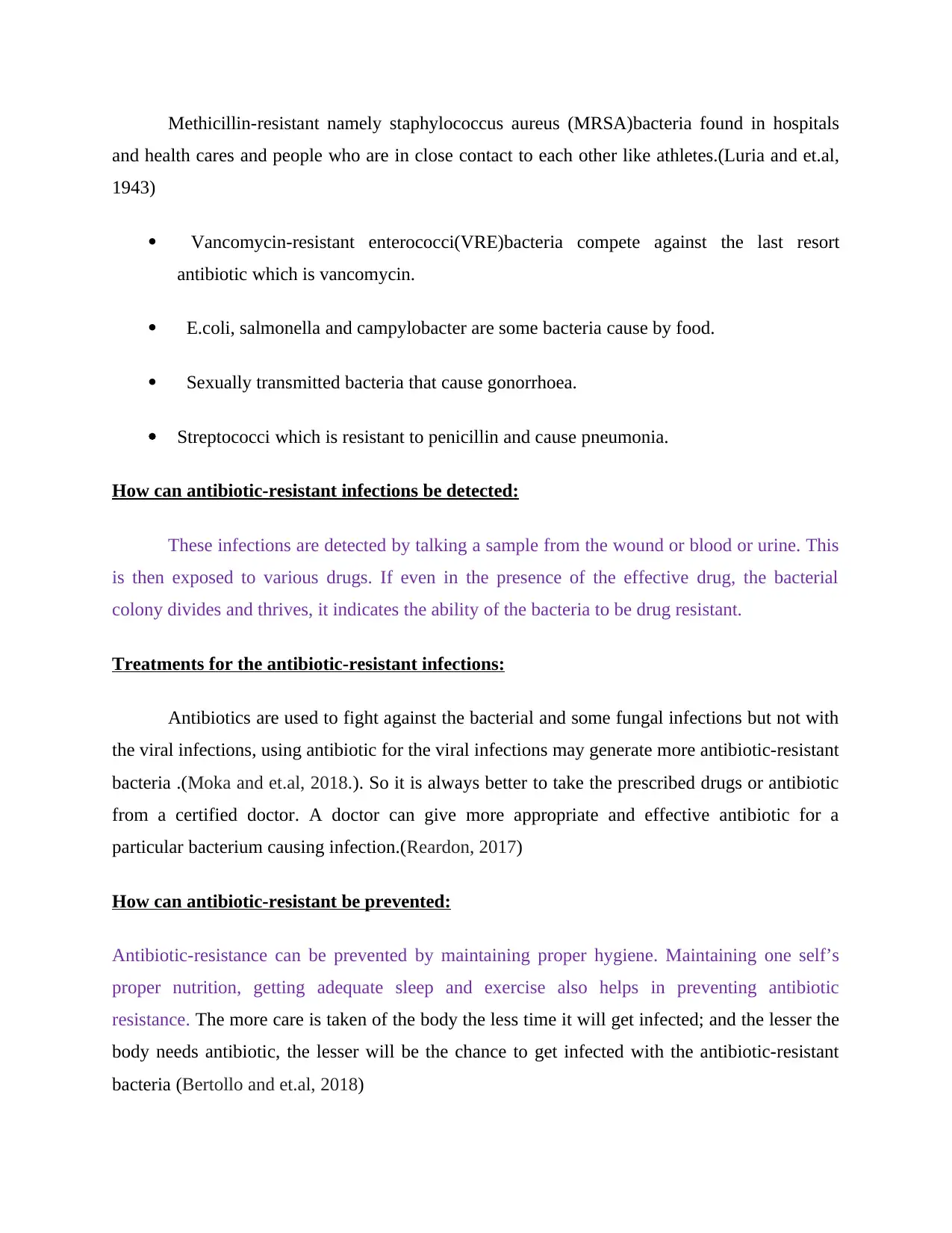
Methicillin-resistant namely staphylococcus aureus (MRSA)bacteria found in hospitals
and health cares and people who are in close contact to each other like athletes.(Luria and et.al,
1943)
Vancomycin-resistant enterococci(VRE)bacteria compete against the last resort
antibiotic which is vancomycin.
E.coli, salmonella and campylobacter are some bacteria cause by food.
Sexually transmitted bacteria that cause gonorrhoea.
Streptococci which is resistant to penicillin and cause pneumonia.
How can antibiotic-resistant infections be detected:
These infections are detected by talking a sample from the wound or blood or urine. This
is then exposed to various drugs. If even in the presence of the effective drug, the bacterial
colony divides and thrives, it indicates the ability of the bacteria to be drug resistant.
Treatments for the antibiotic-resistant infections:
Antibiotics are used to fight against the bacterial and some fungal infections but not with
the viral infections, using antibiotic for the viral infections may generate more antibiotic-resistant
bacteria .(Moka and et.al, 2018.). So it is always better to take the prescribed drugs or antibiotic
from a certified doctor. A doctor can give more appropriate and effective antibiotic for a
particular bacterium causing infection.(Reardon, 2017)
How can antibiotic-resistant be prevented:
Antibiotic-resistance can be prevented by maintaining proper hygiene. Maintaining one self’s
proper nutrition, getting adequate sleep and exercise also helps in preventing antibiotic
resistance. The more care is taken of the body the less time it will get infected; and the lesser the
body needs antibiotic, the lesser will be the chance to get infected with the antibiotic-resistant
bacteria (Bertollo and et.al, 2018)
and health cares and people who are in close contact to each other like athletes.(Luria and et.al,
1943)
Vancomycin-resistant enterococci(VRE)bacteria compete against the last resort
antibiotic which is vancomycin.
E.coli, salmonella and campylobacter are some bacteria cause by food.
Sexually transmitted bacteria that cause gonorrhoea.
Streptococci which is resistant to penicillin and cause pneumonia.
How can antibiotic-resistant infections be detected:
These infections are detected by talking a sample from the wound or blood or urine. This
is then exposed to various drugs. If even in the presence of the effective drug, the bacterial
colony divides and thrives, it indicates the ability of the bacteria to be drug resistant.
Treatments for the antibiotic-resistant infections:
Antibiotics are used to fight against the bacterial and some fungal infections but not with
the viral infections, using antibiotic for the viral infections may generate more antibiotic-resistant
bacteria .(Moka and et.al, 2018.). So it is always better to take the prescribed drugs or antibiotic
from a certified doctor. A doctor can give more appropriate and effective antibiotic for a
particular bacterium causing infection.(Reardon, 2017)
How can antibiotic-resistant be prevented:
Antibiotic-resistance can be prevented by maintaining proper hygiene. Maintaining one self’s
proper nutrition, getting adequate sleep and exercise also helps in preventing antibiotic
resistance. The more care is taken of the body the less time it will get infected; and the lesser the
body needs antibiotic, the lesser will be the chance to get infected with the antibiotic-resistant
bacteria (Bertollo and et.al, 2018)
Paraphrase This Document
Need a fresh take? Get an instant paraphrase of this document with our AI Paraphraser

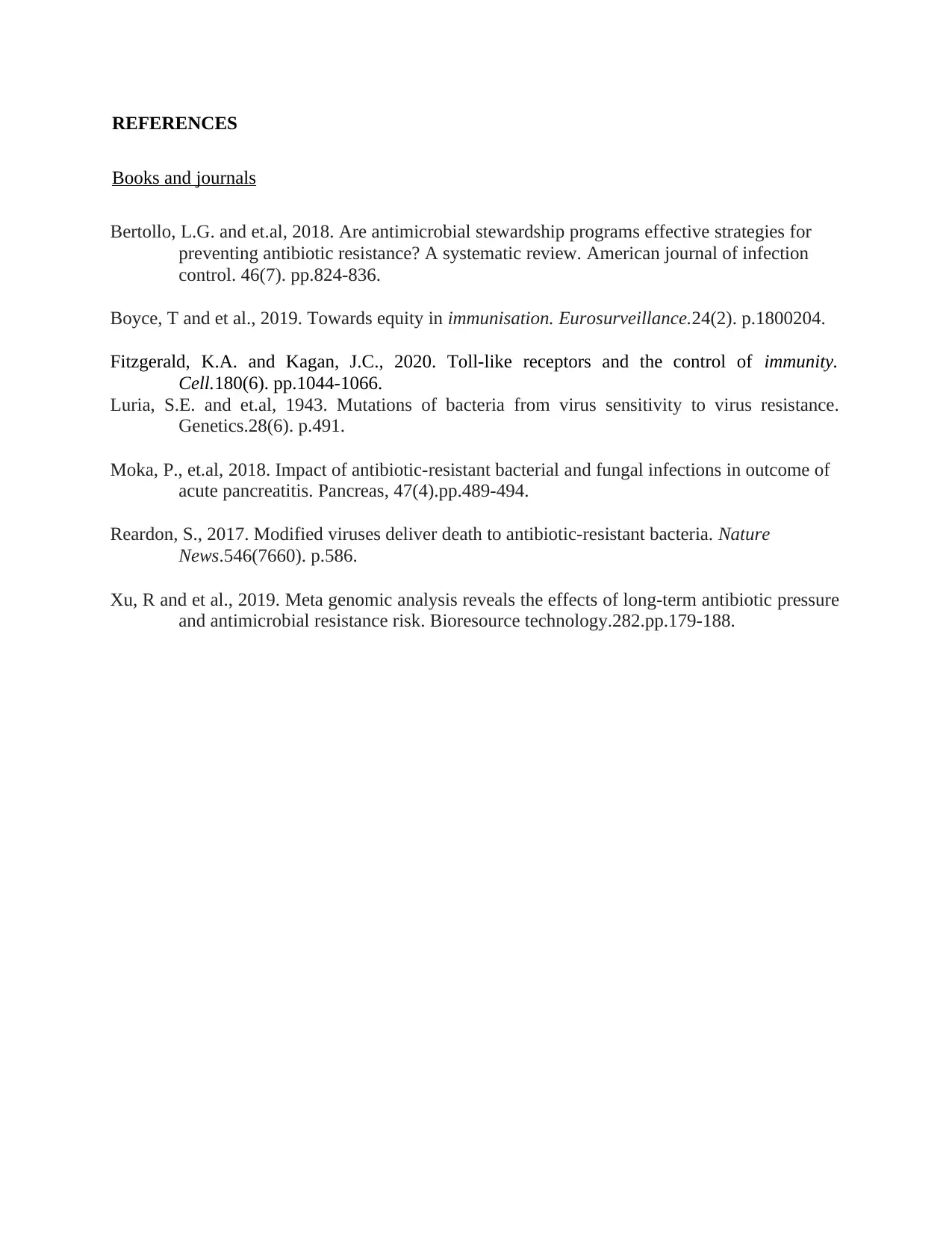
REFERENCES
Books and journals
Bertollo, L.G. and et.al, 2018. Are antimicrobial stewardship programs effective strategies for
preventing antibiotic resistance? A systematic review. American journal of infection
control. 46(7). pp.824-836.
Boyce, T and et al., 2019. Towards equity in immunisation. Eurosurveillance.24(2). p.1800204.
Fitzgerald, K.A. and Kagan, J.C., 2020. Toll-like receptors and the control of immunity.
Cell.180(6). pp.1044-1066.
Luria, S.E. and et.al, 1943. Mutations of bacteria from virus sensitivity to virus resistance.
Genetics.28(6). p.491.
Moka, P., et.al, 2018. Impact of antibiotic-resistant bacterial and fungal infections in outcome of
acute pancreatitis. Pancreas, 47(4).pp.489-494.
Reardon, S., 2017. Modified viruses deliver death to antibiotic-resistant bacteria. Nature
News.546(7660). p.586.
Xu, R and et al., 2019. Meta genomic analysis reveals the effects of long-term antibiotic pressure
and antimicrobial resistance risk. Bioresource technology.282.pp.179-188.
Books and journals
Bertollo, L.G. and et.al, 2018. Are antimicrobial stewardship programs effective strategies for
preventing antibiotic resistance? A systematic review. American journal of infection
control. 46(7). pp.824-836.
Boyce, T and et al., 2019. Towards equity in immunisation. Eurosurveillance.24(2). p.1800204.
Fitzgerald, K.A. and Kagan, J.C., 2020. Toll-like receptors and the control of immunity.
Cell.180(6). pp.1044-1066.
Luria, S.E. and et.al, 1943. Mutations of bacteria from virus sensitivity to virus resistance.
Genetics.28(6). p.491.
Moka, P., et.al, 2018. Impact of antibiotic-resistant bacterial and fungal infections in outcome of
acute pancreatitis. Pancreas, 47(4).pp.489-494.
Reardon, S., 2017. Modified viruses deliver death to antibiotic-resistant bacteria. Nature
News.546(7660). p.586.
Xu, R and et al., 2019. Meta genomic analysis reveals the effects of long-term antibiotic pressure
and antimicrobial resistance risk. Bioresource technology.282.pp.179-188.
⊘ This is a preview!⊘
Do you want full access?
Subscribe today to unlock all pages.

Trusted by 1+ million students worldwide
1 out of 9
Related Documents
Your All-in-One AI-Powered Toolkit for Academic Success.
+13062052269
info@desklib.com
Available 24*7 on WhatsApp / Email
![[object Object]](/_next/static/media/star-bottom.7253800d.svg)
Unlock your academic potential
Copyright © 2020–2025 A2Z Services. All Rights Reserved. Developed and managed by ZUCOL.





